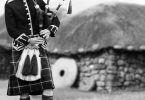Tens of millions of Americans (and even more people around the world) have Irish ancestry. As such, it is worth it to know a little bit about Irish traditions, because they can be an important part of your family history. In fact, if you have Irish ancestry, you may still be practicing some Irish customs or may want to include them in your new family traditions to celebrate your ancestors. Knowing Irish traditions can also help you understand the daily lives of your Irish ancestors better, which is an important part of personalizing genealogy.
Here are some Irish wedding traditions you should know if you have Irish ancestry.
The Art of Handfasting
This is also called “tying the knot” and is an important and ancient Irish wedding tradition. It has been around since Medieval times. This is the practice of tying the hands of the bride and groom together during a marriage ceremony. It is supposed to symbolize their new union.
Long ago, potential brides and grooms might have spent several days tied together, as they decided if they really wanted to spend their lives as husband and wife. In modern Irish weddings, it is part of the ceremony and an homage to the traditions of the past.
Handfasting was a legal form of marriage in Ireland from the 7th century A.D. until the late 1500s when English Queen Elizabeth I made further English expansions into Ireland and made the practice illegal. It was still done in secret and is today an important symbolic part of many Irish marriages around the world.
Cooking the Goose
If you have ever heard the phrase “his goose is cooked,” it comes from this ancient Irish wedding tradition. In the past in Ireland, the day before a wedding was announced to the village, the family of the bride would cook dinner for the groom at their home. The traditional meal for this meeting was a goose. While the goose was cooking, the groom and the bride’s parents would sign important contracts related to the upcoming marriage, such as land rights and dowry portions. Once the goose was done cooking, the groom’s decision to marry the bride was considered to be solidified. He had to marry her after the goose was cooked.
The Claddagh Ring
Outside the old city walls of Galway, Ireland is a small fishing village called Claddagh. It was there that the famous Claddagh ring is said to have been invented by a talented blacksmith who set aside enough gold dust over the years to make the first one. The ring features two hands clasping each other over a crowned heart, which is a symbol of love, commitment, and loyalty.
Claddagh rings are passed down the female line in Ireland, and can be quite ancient in some families, or brand new in others. Word on the right hand, the Claddagh ring lets a potential suitor know the woman is single. Worn on the left, it shows she is married. If it is passed down the bride’s family and used as a wedding ring, there is no need for the groom to buy a new one to use at the wedding.






